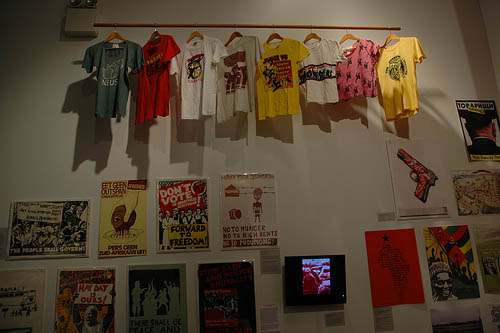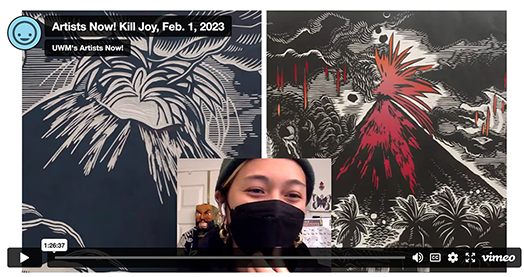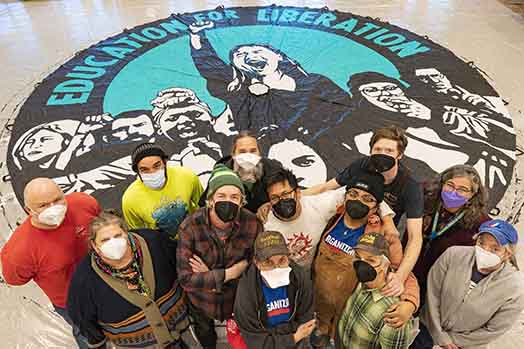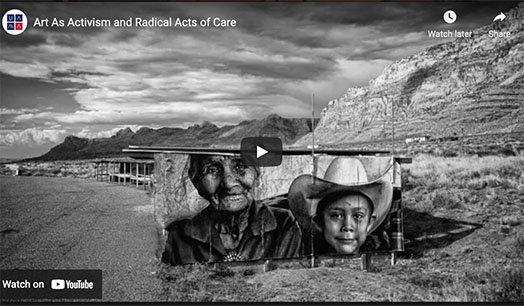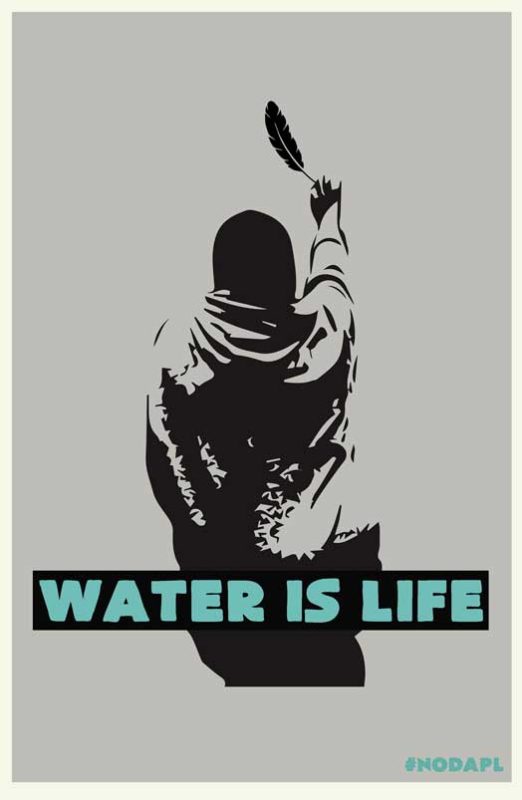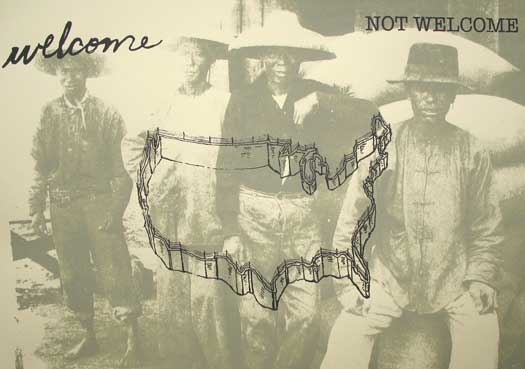Posted below is the long version of an exhibition review of Signs of Change that I wrote for the April/May issue of Left Turn.
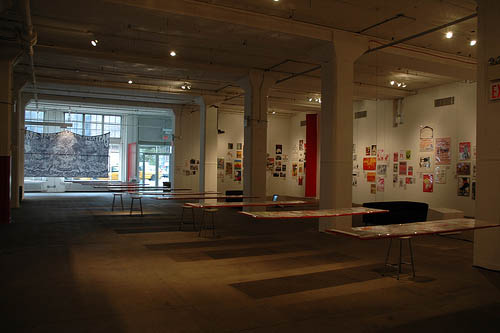
800 Images, Histories, and Struggles: A Review of “Signs of Change: Social Movement Cultures 1960s to Now”
For radical artists and activists, the first experience of walking into Signs of Change: Social Movement Cultures 1960s to Now at Exit Art is like a kid walking into a candy store. Where to begin? Everything looks good. The walls of the 5000 square foot exhibition space are covered with an array of posters, prints and flyers from over five decades of social and environmental movements from around the world. Additionally, a row of tables that occupies the center ally of the gallery contains hundreds of items of ephemera, and video projections and monitors are strategically placed throughout the gallery showing documentation of numerous artists and art collectives. All told, upwards of eight hundred examples of activist art are presented.
A short list of some of the movements addressed within the show include the Black Panther Movement, the American Indian Movement, the squatters movement in the US and Europe, political liberation movements in Africa, anti-Apartheid movements in South Africa, democracy movements in China, global environmental and anti-nuke movements, anti-Vietnam War movements, Chicana/o farm worker movements, the Zapatista uprising, global AIDS activism, and Reclaim the Streets.
The show was curated by two Brooklyn-based artist/activists Dara Greenwald and Josh MacPhee through the Exit Art Curatorial Incubator Program. MacPhee largely focused on the prints and posters and Greenwald on the films and videos. Together, they also organized an ambitious program of panel discussions, film screenings, and screen-printing workshops. All told, Greenwald and MacPhee turned Exit Art into an epicenter of art and activism for the duration of the shows run from September 20 – December 6th. The result is arguably one of the more vital and interesting political art shows to emerge in a long time — a show that raises key questions and insight regarding the art of social movements, the role of artists in these movements, and the complex and sometimes contradictory practice of exhibiting radical art within large-scale retrospective shows.
On first viewing, it is difficult not to be deeply impressed by Signs of Change. Much of the work exhibited is obscure thus one of the most important functions of the show is making it visible. Not only in terms of presenting the images and films themselves, but by emphasizing the critical role that artists have played in movements – a focus that is sorely lacking in so much of the scholarship and attention given towards past and present social movements. Signs of Change addresses this void and provides a litany of examples on how artists have contributed to movements worldwide. Combined the sheer volume of images in Signs of Change speaks of a culture of resistance and grouped together they form a type of visual solidarity.
That said, there are advantages and disadvantages to showing so much work for Greenwald and MacPhee strike an uneasy balance between being all-inclusive and submerging the power and complexities of each piece. Eight hundred works is a huge amount of information to take in and individual works can get lost in the sea of images. This becomes problematic because the history behind each individual work becomes secondary, as does an appreciation for how the images were originally utilized during the movements.
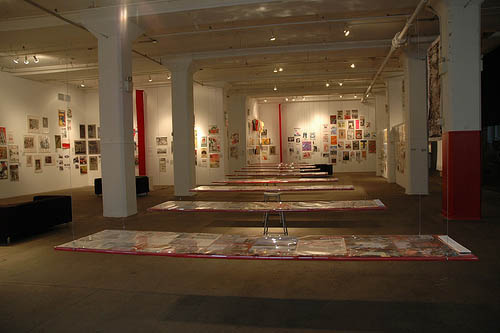
Greenwald and MacPhee partially remedied this by adding a short description tag to each work and they arranged posters, prints and videos within specific sections. Yet, the categories and the short descriptions on the labels does not significantly address the complex history behind each image, nor does it give the viewer much appreciation of how the images were employed.
An exception to the lack of focus on the tactics is the documentary films and videos that are spread out amongst the gallery. In the majority of cases, each film provides a compelling look into an artist collective or movement that shows the artists in action. Notable films and videos that immediately caught my attention was the documentary of the Taring Padi art collective in Indonesia that documents their studio (a squatted school building), the artists creating prints, and the extraordinary repression that the artists face (in one case, thugs with machetes try to hunt them down on mopeds.) Another powerful video documents a recent action by Iraq Veterans Against the War (IVAW) performing a mock “search raid” in Denver that recreates the tactics of US soldiers searching through residential neighborhoods in Iraq.
The selection of films and videos that document how the work was employed is one of the strongest aspects of the show and it would have been good to see similar documentation for the print based work. Had the curators included more photographs and documentation of the posters up in the streets, in marches, or a short statement by the artist or artist’s collectives, or more documentary films and videos this would of provided the necessary context. For without this context, the work falls more into the realm of aesthetics and objects and the viewer focuses more on appreciating the graphic quality of the work rather than how they were employed. This point is reinforced by how the work was hung that differs little from other large group art shows that are based upon a theme. Considering the vast amount of images providing documentation would have been a monumental task but one way to avoid this would have been to include far less images and movements covered within the exhibit.
This critique of Signs of Change, however, certainly does not diminish the shows significance, nor does it diminish the curator’s decision on how to stage the exhibit. Greenwald and MacPhee chose to be inclusive and all encompassing, rather than specific, thus the show seen as a whole provides a window for the viewer to learn more about the individual works, artists, collectives and the history that is represented. The exhibit acts as the start of an inquiry and not as a definitive statement. Greenwald and MacPhee provided the vast bibliography of images and invite the audience to take the next step to research the work, the artists, and the various movements connected to the work. In doing so, the curators made obscure work much less invisible and made our job much easier to locate this work. And considering that exhibitions featuring visual culture from social movements are rare, the curator’s choice to include a vast amount of images serves as a good entry point and introduction that sets the stage for more focused exhibitions in the future. Yet, we should not lose sight that the exhibition itself is only part of the equation for Signs of Change is so vital for what it accomplishes outside the gallery. Signs of Change encourages artists today to become involved and equally important, it encourages the movements of today to involve artists.
-Nicolas Lampert
Signs of Change is on exhibit at the Miller Gallery at Carnegie Mellon University in Pittsburgh (Jan. 23–March 8, 2009.) Additionally, an exhibition catalog is published through AK Press.
